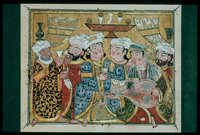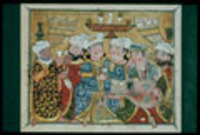Woman Playing the Lute
Maqamat (Assemblies) of al-Hariri
| dc.coverage.spatial | Creation location: Cairo (Egypt) | en_US |
| dc.creator | Hariri | en_US |
| dc.date.accessioned | 2007-07-23T17:49:37Z | |
| dc.date.available | 2007-07-23T17:49:37Z | |
| dc.identifier | 029265 | en_US |
| dc.identifier.uri | http://hdl.handle.net/1721.3/19887 | en_US |
| dc.description | 6 figures (3 men, 3 women); one woman playing lute; two male figures and one female holding glasses1) "A second, equally distinctive style emerged during the second quarter of the 14th century. The earliest example is found in a copy of the Maqamat (1333–4; Vienna, Österreich. Nbib., MS. A.F. 9). The style of illustration has many similarities with contemporary Koran illumination (see §3(i) above) and the chinoiserie style found in Iranian manuscripts of the same period (see §§(b) and (c) below). All the manuscripts in this tight group are lavishly decorated. The paintings are executed on a gold ground and have a thick gold frame surrounded by a ruled blue line with finials at each corner. The text is ornamented with whirling gold rosettes and illuminated chapter-headings in the manner of contemporary Korans. Despite the gold ground, the illustrations experiment with landscape and composition; they use the frame to create spatial tension and allow figures or animals to break out of it for increased dramatic effect. These spatial experiments and the exotic flora and fauna depicted—lotuses, peonies, gnarled trees, phoenixes and dragons—show the impact of Chinese pictorial conventions, which were probably received via Persian illustrated manuscripts as well as from the Chinese textiles and porcelains so popular at the Mamluk court. A new figural type with heavy Mongol features and thick black hair is probably intended to resemble members of the Mamluk élite." 2) "Before the end of the 14th century most patrons and collectors of illustrated literary manuscripts were not the Turkish-speaking Mamluks but educated members of the Arabic-speaking middle class, which included the sons of Mamluks. Several illustrated manuscripts contain the names of sons of Mamluks, and, although Arab patrons were not in the habit of adding their names to manuscripts, the name of a tax inspector from Damascus appears on a copy (1323; London, BL, Add. MS. 7293) of the Maqamat (‘Assemblies’) of al-Hariri, which he bought in 1375–6. Many of the texts popular with these patrons—the tales of the roguish adventurer Abu Zayd that al-Hariri brought together in his Maqamat..." | en_US |
| dc.description | full view, 2000 | en_US |
| dc.format.medium | paper (fiber product) | en_US |
| dc.format.medium | parchment | en_US |
| dc.format.medium | vellum (parchment) | en_US |
| dc.relation.ispartof | 104820 | en_US |
| dc.subject | Banquets | en_US |
| dc.subject | Fables | en_US |
| dc.subject | Lutes | en_US |
| dc.subject | Miniatures (Paintings) | en_US |
| dc.subject | Musical instruments | en_US |
| dc.subject | Prostitutes | en_US |
| dc.subject | Travel literature | en_US |
| dc.subject | Lutenists | en_US |
| dc.subject | Islam -- History | en_US |
| dc.subject | Kings and rulers | en_US |
| dc.subject | Hariri, 1054-1122 | en_US |
| dc.subject | Harairi, 1054-1122. Maqamat. Persian & Arabic | en_US |
| dc.subject | Tales | en_US |
| dc.subject | Illumination of books and manuscripts, Islamic | en_US |
| dc.title | Woman Playing the Lute | en_US |
| dc.title | Maqamat (Assemblies) of al-Hariri | en_US |
| dc.type | Image | en_US |
| dc.rights.access | All rights reserved | en_US |
| dc.publisher.institution | Repository: Österreichische Nationalbibliothek (Vienna, Austria) | en_US |
| vra.culturalContext | Islamic | en_US |
| vra.culturalContext | Egyptian (modern) | en_US |
| vra.technique | handwriting | en_US |
| vra.technique | illustration (process) | en_US |
| vra.worktype | Manuscript (document genre) | en_US |
| vra.worktype | Miniature (painting) | en_US |
| dc.contributor.display | author: text by Hariri (Islamic, 1054-1122) | en_US |
Files in this item
This item appears in the following Collection(s)
-
Architecture, Urban Planning, and Visual Arts
Online Image Collection


